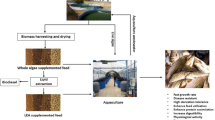Abstract
The concurrent trends of increasing consumption of seafood and decreasing natural harvests will dictate that a larger portion of seafood must be derived from aquaculture in the 21st century. The difficulty of producing economically large quantities of microalgal feeds is currently one of the major impediments to the further development of the aquaculture industry. Traditional methods, which rely on photosynthetic growth in outdoor ponds or indoors under artificial lights, suffer from the phenomenon of light-limitation of biomass density. Certain species of microalgae are capable of heterotrophic growth to high density utilizing sugars or other organic compounds for energy and cell carbon. This paper reviews work with strains of heterotrophic algae that have demonstrated potential as both nutritional feeds and for economical production by fermentation.
Similar content being viewed by others
References
Ben-Amotz A, Fishler R, Schneller A (1987) Chemical composition of dietary species of marine unicellular algae and rotifers with emphasis on fatty acids. Mar. Biol. 95: 31–36.
Brown A (1972) Experimental techniques for preserving diatoms used as food for larvalPenaeus aztecus. Proc. nat. Shellfisheries Assoc. 62: 21–25.
Chamberlain GW (1993) Aquaculture trends. World Aquaculture 24: 19–29.
Crueger W, Crueger A (1989) Biotechnology: A Textbook of Industrial Microbiology. Sinauer Associates, Inc., Sunderland, Mass., 357 pp.
Demain AL, Solomon NA (eds) (1986) Manual of Industrial Microbiology and Biotechnology. Amer. Soc. Microbiol. Washington, D.C., 466 pp.
De Pauw N, Persoone G (1988) Microalgae for aquaculture. In Borowitzka MA, Borowitzka LJ (eds), Microalgal Biotechnology. Cambridge U.P., Cambridge: 197–221.
Droop MR (1974) Heterotrophy of carbon. In Stewart WDP (ed.), Algal Physiology and Biochemistry, Botanical Monographs, Vol. 10, Univ. Calif. Press, Berkeley, 530–559.
Fulks W, Main KL (eds) (1991) Rotifer and Microalgae Culture Systems. Proceedings of a U.S.-Asia Workshop. The Oceanic Institute, Honolulu, 364 pp.
Gladue R (1991) Heterotrophic microalgae production: potential for application to aquaculture feeds. In Fulks W, Main KL (eds), Rotifer and Microalgae Culture Systems. Proceedings of a U.S.-Asia Workshop. The Oceanic Institute, Honolulu: 275–286.
Guillard RRL (1975) Culture of phytoplankton for feeding marine invertebrates. In Smith WL, Chanley HH (eds), Culture of Marine Invertebrate Animals. Plenum Press, New York: 29–60.
Hanson RS, Phillips JA (1981) Chemical composition. In Gerhardt P, Murray RGE, Costilow RN, Nester EW, Wood WA, Krieg NR, Phillips GB (eds), ASM Manual of Methods for General Bacteriology. Amer. Soc. Microbiol., Washington, D.C.: 328–364.
Hellebust JA, Lewin J (1977) Heterotrophic nutrition. In Werner D (ed.), The Biology of the Diatoms, Univ. Calif. Press, Berkeley: 169–197.
Hirayama K, Satuito CG (1991) The nutritional improvement of baker's yeast for the growth of the rotifer,Brachionus plicatilis. In Fulks W, Main KL (eds), Rotifer and Microalgae Culture Systems. Proceedings of a U.S.-Asia Workshop. The Oceanic Institute, Honolulu: 151–162.
Jones DA, Kamarudin MS, LeVay L (1993) The potential for replacement of live feeds in larval culture. Journal of the World Aquaculture Society 24: 199–210.
Kalk JP, Langlykke AF (1986) Cost estimation for biotechnology projects. In Demain AL, Solomon NA (eds), Manual of Industrial Microbiology and Biotechnology. Amer. Soc. Microbiol. Washington, D.C.
Neilson AH, Lewin RA (1974) The uptake and utilization of organic carbon by algae: An essay in comparative biochemistry. Phycologia 13: 227–264.
Okauchi M (1991) The status of phytoplankton production as food organisms in Japan. In Fulks W, Main KL (eds), Rotifer and Microalgae Culture Systems. Proceedings of a U.S.-Asia Workshop. The Oceanic Institute, Honolulu: 247–256.
Ryther JH, Goldman JC (1975) Microbes as food in mariculture. Annu. Rev. Microbiol. 29: 429–443.
Snell TW (1991) Designing optimal systems for the mass culture of rotifers. In Fulks W, Main KL (eds), Rotifer and Microalgae Culture Systems. Proceedings of a U.S.-Asia Workshop. The Oceanic Institute, Honolulu: 61–71.
Soong P (1980) Production and development ofChlorella andSpirulina in Taiwan. In Shelef G, Soeder CJ (eds), Algae Biomass. Production and Use. Elsevier/North Holland Biomedical Press, Amsterdam; 97–113.
Watanabe T (1988). Nutrition and growth. In Shepherd CJ, Bromage NR (eds), Intensive Fish Farming. BSP Professional Books, Oxford.
Yee L, Blanch HW (1992) Recombinant protein expression in high cell density fed-batch cultures ofEscherichia coli. Biotechnology 10: 1550–1556.
Author information
Authors and Affiliations
Rights and permissions
About this article
Cite this article
Gladue, R.M., Maxey, J.E. Microalgal feeds for aquaculture. J Appl Phycol 6, 131–141 (1994). https://doi.org/10.1007/BF02186067
Received:
Revised:
Accepted:
Issue Date:
DOI: https://doi.org/10.1007/BF02186067




